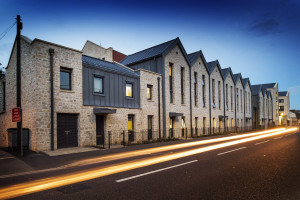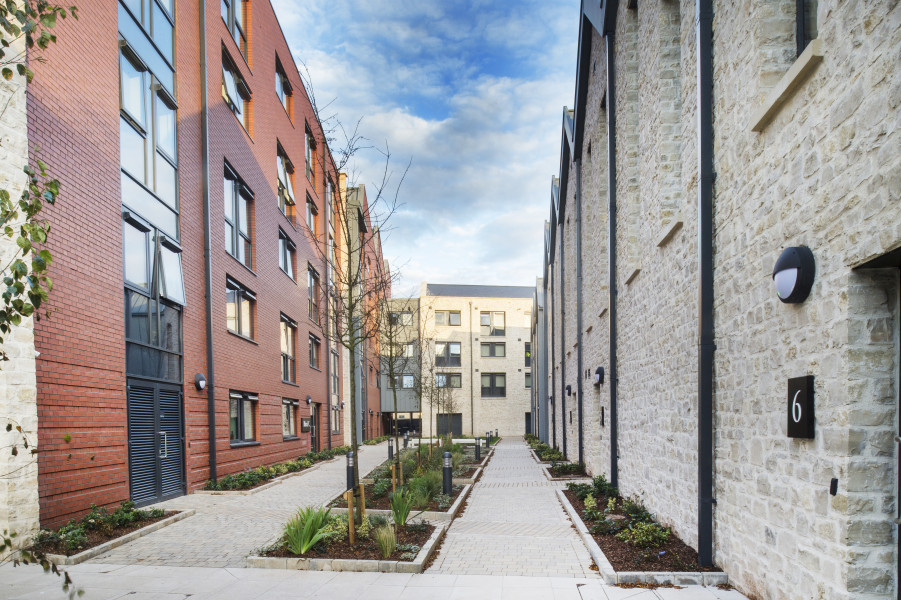The recently completed 7,500m2 Twerton Mill development offers 327 premium student living units, located on a site steeped in industrial heritage and within a popular student and local residential area. Built by Midas Construction Limited, the project was commissioned to tackle an accommodation shortage across the city, where the rising student presence has contributed to 67% of population growth within recent years. Based on a challenging site, the use of the JCT 2011 Design and Build contract provided a good balance of cost certainty with flexibility when resolving ad-hoc construction issues.
Introduction
The city of Bath is globally renowned for its elegant architecture, extensive use of locally sourced limestone, and a proud history of industrial and manufacturing prominence. These characteristics have formed a distinctive local vernacular, and maintaining this image across the Twerton Mill site was a key development objective. The architect achieved this aim by incorporating structures resembling both town houses and industrial buildings into the design. Based on real examples from the city and surrounding area, these designs create a seamless aesthetic transition from the new development to its neighbouring buildings.
The finishing materials were carefully chosen to enhance this resemblance. Coursed random 2016rubble stone cladding, quarried locally in Somerset, was used on the town houses as a cost-effective alternative to traditional Bath Stone. Additionally, red engineering bricks were placed around north-facing roof lights, popular in 20th century manufacturing buildings, to complete the industrial style accommodation blocks. One of the blocks incorporates full-height feature glazing at its gable ends, displaying the industrial-themed decoration within, and sections of the original mill wall and iconic gates at the entrance to the site have been refurbished and blended into the new design.
Features
The Twerton Mill student accommodation development features six distinct buildings in total, comprising a mix of 2/3-storey town houses and 4/5-storey residential blocks, each with a range of accommodation and communal facilities. Five of the buildings were constructed adjoining at least one of the others, with town houses connected to residential blocks at varying levels. Accommodation comprises a mixture of self-contained studios with en suite bathrooms and kitchenettes, and cluster bedrooms with en suite bathrooms arranged around common kitchen and dining areas. Communal and operational facilities built across the site include the main reception, office, gym, laundry, common room, cycle and bin stores, and substations and plant rooms.External communal spaces were also created, with two courtyards formed with a mixture of slab and brick paviers and heritage kerbs, and landscaped patterned green areas planted with trees and shrubbery.

Challenges
The project was undertaken on a constrained brownfield site adjacent to the A36, one of the two main roads leading into Bath from the west. The site is situated half a mile from the city centre, and is bound on the east and west sides by commercial and residential properties, to the north by the River Avon, and to the south by the A36, with a raised Network Rail line on the opposing side. The site sits above the Bath aquifer, the body of rock through which the
Bath hot springs water runs. The new building footprints were positioned close to the site boundary to make optimal use of available space, and left a small area at the centre of the site to form a courtyard upon completion. The main issues facing the project team, pre and post-commencement, revolved around the site location, the condition of the ground, the lack of space available, ensuring the effective programming of building interface work (linking the separate buildings) and the incapacity of existing services to accommodate the new development.
Challenge 1 – Programming and interfacing buildings
To achieve the project completion deadline, set to meet the needs of the new student intake in September 2015, programming challenges had to be overcome; specifically with addressing the construction of multiple buildings and the interface of those buildings, in combination with the constrained nature of the site.
The construction of the North and South blocks produced challenges with programming and construction sequencing. Due to the connecting interface between buildings, temporary works were necessary to ensure rain water ingress was mitigated to allow the fit out of the South blocks to run in tandem with the completion of envelope works on the North blocks. To ensure effective progress against programme the project team worked closely with the design team and supply chain members to create exhaustively detailed programmes of works that kept trades segregated.
The last planner review technique was implemented to monitor programme risks and works progression across the numerous trades working on the site at the same time. Each proposed programme was reviewed at commencement, with earliest possible start and latest possible finish dates for each package used to plot S-curves on the corresponding Gantt chart, which in turn were used to highlight programme risks. These risks were then closely monitored, and precautionary plans created.
Challenge 2 – Adjacent to arterial road and Network Rail
The challenges presented by the site’s location adjacent to an arterial city road and Network Rail line were two-fold, firstly affecting the construction works, and secondly requiring building features to optimise noise mitigation within the development.
The delivery and on-site movement of materials was a complex issue. The site team used Zone Manager, a web-based booking system, to coordinate deliveries and avoid obstruction to the busy arterial city road adjacent to the site. Deliveries were restricted to outside of peak traffic hours, and the booking system ensured that the high volume of construction traffic required was evenly spaced with clear windows between each vehicle arrival and departure.
Two tower cranes were erected on site, and a series of cranes and hoists were installed to facilitate the movement of materials. The senior project manager maintained close liaison with Network Rail representatives to ensure that all corresponding method statements were created in line with rail requirements, including restrictions on the size, type and movement of crane used.
In order to successfully mitigate noise transfer from the road and rail line into the new buildings, high performance double glazed windows with integral noise attenuated ventilation units were installed. This feature provided the double benefit of a high level of noise reduction plus natural ventilation.
Challenge 3 – Ground contamination
The site had previously been used as a location for motor vehicle garages and workshops, resulting in significant petrochemical contamination within the ground. The team created a comprehensive remediation strategy, employing a specialist contractor to assist with the rapid extraction and treatment of affected material in order for critical path groundworks to progress in line with the construction progress. Remediation of contaminated materials, both on site and at a specialist treatment plant, led to the re-classification of materials from hazardous to non-hazardous, and from non-hazardous to inert.
Challenge 4 – Interaction with council drainage network
The development included the construction of a large combined sewer overflow system (CSO), required by the local water authority to alleviate pressure on the existing local drainage network. The installation included a high specification telemetry system, providing the water authority with remote monitoring. The CSO had to be constructed in an extremely constricted area within a narrow lane adjacent to the site. Requiring deep excavations and extensive temporary works the construction could only be carried out towards the end of the project, and complex reprogramming of several elements of works was undertaken to ensure the installation was completed on time for student occupation.
Summary
The Twerton Mill development is an example of how intelligent design and creative problem solving can be combined to breathe new life into challenging sites. Collaboration between the design team, contractor and supply chain promoted innovation and the optimal use of all this location has to offer, allowing challenging aspects of the project to be incorporated into the final building’s defining features.
Key Facts
Contract: JCT DB 2011
Cost: £16.86m
Start: May 2014
Completion: September 2015
Internal Floor Area: 7,500m2
Architect: Stride Treglown Limited
Client: McLaren Limited
Structural Engineer: Waldeck Consulting
M&E Consultant: MTT Limited
Quantity Surveyor: Quantem Consulting LLP
Main Contractor: Midas Construction Limited
Daniel Hill is Proposals Coordinator at Midas Group Ltd.

